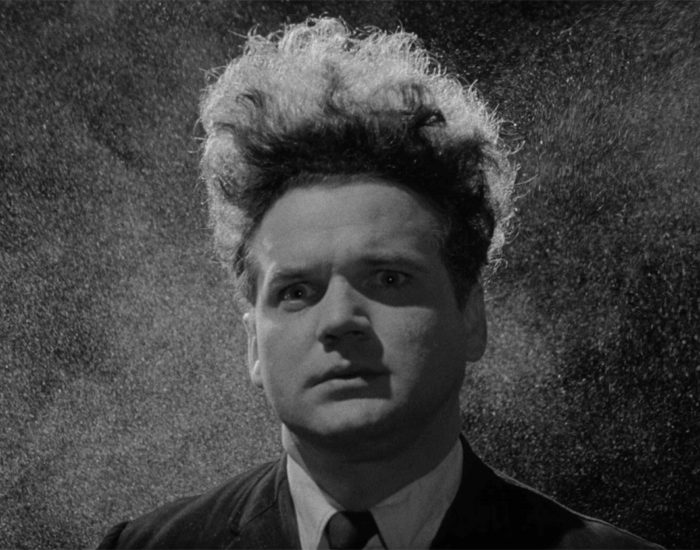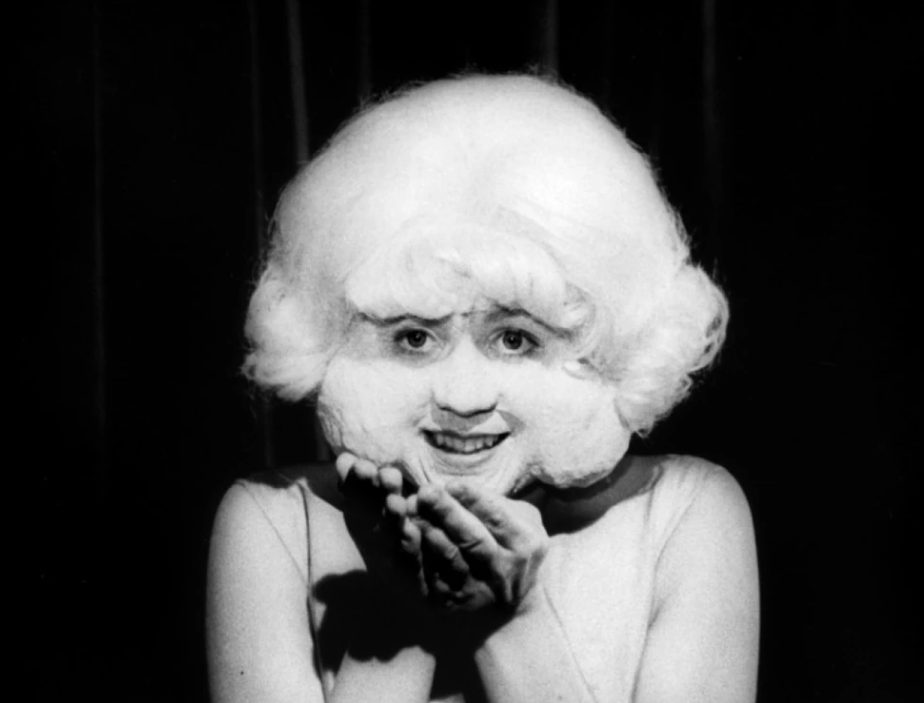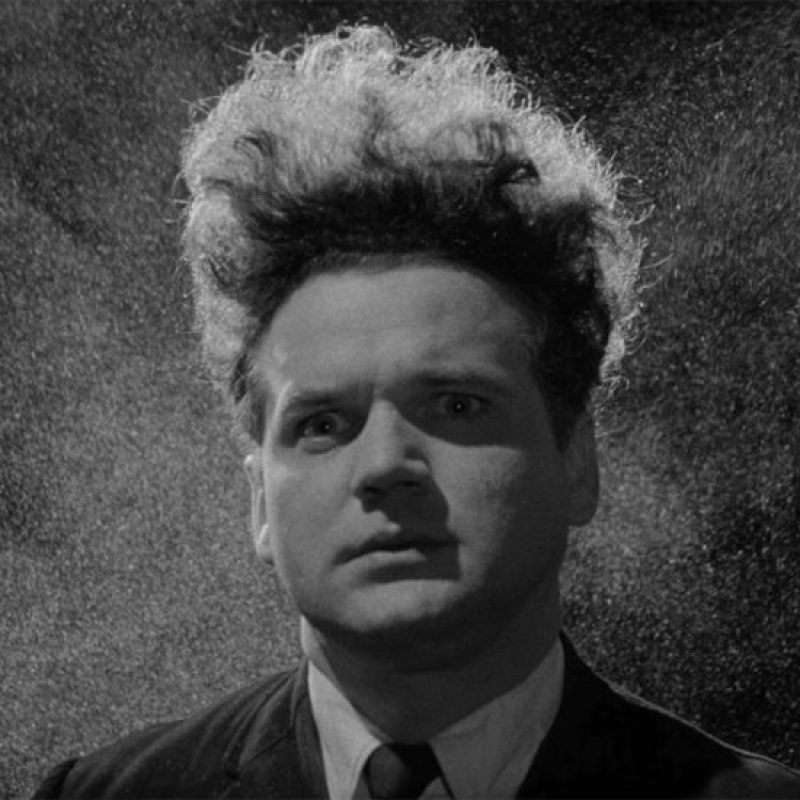Blog post by David Longford (original co-producer of the Nottingham Puppet Festival who will be introducing the Eraserhead screening at Broadway Cinema on 17 Apr)
“Ever had a dream while sleeping face down, with your mouth and nose buried in your pillow? In your discomfort you might have conjured up something that approximates Eraserhead.” [1]
I remember well the first time I saw Eraserhead, David Lynch’s 1977 masterpiece.
It was around 1984, my A level year. Definitely August. And daytime. That’s important.
My parents were at work, and I was slouching at home, ‘preparing’ for a gap year. These days that involves trekking around South America and discovering yourself. For me, it was signing on, playing snooker and the pub.
Channel 4 had broadcast Eraserhead late at night. I recorded it on our rented VHS player, along with the television, from Multi-Broadcast. That’s what you did back then.
I knew that this was a film I needed to watch on my own, as my parents wouldn’t like it. It didn’t star anyone they knew of, nor was it an adaptation of a Catherine Cookson novel.
I was aware of Eraserhead and its director David Lynch, having watched The Elephant Man a few years before. I was 14 and had gone with my brother to see it at our local cinema in Cannock. I knew the story of John Merrick, but this dark, mesmerising depiction of Victorian London was something else. Captivating and haunting.
The Elephant Man was David Lynch’s second film. Producer Mel Brooks had seen Eraserhead and knew he had found his director. As Brooks himself stated, acknowledging his own quirky presence in the story:
“How does a guy who is known for the best fart jokes in cinema go on to make The Elephant Man?” But if you really think about it for a moment, art is art, and it is not so crazy that one great filmmaker would be able to so easily recognize the genius of another.” [2]
Today, a quick Google of Eraserhead reveals countless words and videos discussing the film’s history, as well as offering (and often failing) to make sense of it all. Back then, in my parents’ Staffordshire living room, I just had the knowledge that it was some kind of cult movie, for which I was rapidly discovering a penchant. Thank you Channel 4 and late-night BBC2.
I was also aware of that now classic image of actor Jack Nance as the lead character Henry Spencer, with that extraordinary haircut, looking disturbed and shocked with dust blowing around him. What was all that about? And what exactly is an Eraserhead?

I pressed play and settled down to watch. Eraserhead is dark, both figuratively and literally, filmed in black and white. It was difficult to watch as the August sunshine poured into the room and so I closed the curtains to properly enhance my viewing.
Around this time, I remember going round to my mate Matthew’s house during the day. He too had the curtains closed, but he had been enjoying an altogether different kind of film.
The following 89 minutes watching this deeply strange movie in the semi-darkness, had a profound effect on me. A film of massive contradictions. Genuinely scary, but wildly funny at times. Utterly baffling (why is that woman with the peculiar cheeks living in that radiator?) and yet rooted in a grimy, industrial reality; with its central character an aimless young man experiencing the perils of dating (that certainly resonated), having awkward meals with potential in-laws and coping with parenthood.

Watching Eraserhead that day gave me such a sensation of unease and horror, that I had to pause it halfway through, and go outside and get some air and sunshine. I came back and finished the film. “Oh, so that’s why it’s called Eraserhead!”
What I had experienced for the first time that sunny afternoon was a complete film. An almost total sensory and emotional experience that had wormed itself right into my gut. My many repeated viewings of the film over the years continue that profound dread. How many films or other means of artistic expression are able to wield such power? Eraserhead is unique in so many, many ways.
In his introduction to the 2005 revised edition of Lynch on Lynch, the seminal work on the film-maker, Chris Rodley neatly sums my experience of watching Eraserhead:
“It is not only hard to define the experience of watching a Lynch film, but also to pinpoint exactly what one has actually seen … No other contemporary director works with all the available elements of cinema to the same degree as Lynch does. This is precisely because Lynch has to mobilise every aspect of the film-making process in order to express the elusive quality of the uncanny. His sensitivity to the textures of sound and image, to the rhythms of speech and movement, to space, colour, and the intrinsic power of music, mark him as unique in this respect.”[3]
To have made such a powerful first feature film is extraordinary, particularly when you look at it how came into being. Lynch conceived it in 1971 and started filming in June 1972. Five years later, in March 1977, it premiered at Filmex, a Los Angeles film festival. For those five years Lynch and a small devoted crew, including soundman Alan Splet, and actor Jack Nance, who let’s not forget, sported that haircut for half a decade, laboured over the film.
Eraserhead defines low-budget filmmaking. There was some funding from the American Film Institute, but Lynch was also reliant on loans and donations from his father, actor Sissy Spacek, and Nance’s wife Catherine Coulson, who took on many behind-the scenes roles and was later to become well-known as the Log Lady in Lynch’s Twin Peaks. Lynch even took on a paper round delivering the Wall Street Journal to support himself during filming.
That first screening in LA was markedly low-key. There were just 25 people in the audience. But its notoriety grew and it soon became a regular fixture on the Midnight Movie scene on both the East and West coasts during the late 70s and early 80s.
Lynch has gone on to have a remarkable creative career, producing daring work that pushes us repeatedly into dark and confusing spaces. An artistic journey that truly began with Eraserhead, and now courtesy of Nottingham Puppet Festival, we can get to experience this masterpiece on the big screen.
In 2018, as the then Learning Manager at the Theatre Royal Nottingham, I conceived Nottingham Puppet Festival as an opportunity to celebrate puppetry in all its forms, including some of the genre’s more darker elements. I remember producing a late-night evening of bawdy puppet cabaret at the Theatre Royal as part of the inaugural festival. This was a million miles away from puppetry’s more immediate association with children’s work. I have since moved on to pastures new, but I am delighted to be returning to the 2024 festival, as one of its original co-producers, to introduce Eraserhead at Broadway Cinema and to highlight how puppetry can be utilised to shape a nightmarish vision.
Eraserhead has been named by the BFI as one of the ten great puppet films. The film’s use of puppetry, notably for the famous “baby”, which Lynch has steadfastly refused to discuss how it was made or operated [4], and the strange chickens during the classic dinner scene.
Lynch’s use of puppetry is another key element in the film’s moulding of our unease. Their mis-shapen oddness add to our over-whelming uncanny feelings, and yet are appropriate for the surreal world that Lynch has created.
Lynch also has a clear understanding of the relationship between a puppet and the viewer. Puppetry enables an audience to be united in a collective encounter, being “invited to invest the puppet with emotion and movement, and to see it ‘breathe’” [5] This breath is the key to audience engagement in a puppetry performance, whether on film or in a theatre. We give a puppet life, perhaps through childhood memories of play and through the simplest act of being present.
As puppeteer David Currell reminds us, puppets are inanimate objects and as an audience, we have to be involved:
“Puppets also need to work in the here-and-now, and in concrete terms. They cannot philosophize and cannot reflect on the past; they must be in the moment or moving forward. This is a fundamental principle: the audience must do the philosophizing, not the puppet.” [6]
Despite the horror surrounding the baby in Eraserhead, Danny Peary is right to state that “Lynch is on the side of the child in the film, and by the end of the film, so are we.” [7]
It is through puppetry that we become invested in Henry Spencer’s strange offspring. We allow it to breathe and to mewl its desperate cries. What happens subsequently becomes even more shocking due to our investment in that macabre puppet. I wasn’t a parent when I first saw Eraserhead. The film now has even greater resonance for me.
There is a post-script to my life with Eraserhead.
From that first teenage viewing of the film, I became a life-long fan of Lynch’s work. Twin Peaks redefined television storytelling in the 90s and Twin Peaks: The Return in 2017 was masterful. However, despite my best efforts, it was something that I couldn’t get my family to watch. It simply wasn’t for them.
So, like my 18 year old self, I resorted to recording it, not on VHS this time, and watching it on my own, late at night, with the curtains drawn.
The extraordinary Part 8 with its imagery of the 1945 atomic bomb tests, that produced a much sharper sense of fear and desolation than Christopher Nolan’s Oppenheimer, to the skull-crushing horror of the Woodsman (“Got a light?”) once again produced that gut-wrenching sense of dread and unease, via that Lynchian combination of sound, visuals, music, direction and performance.
Maybe I am just pre-destined to watch and experience Lynch on my own, but I hope that a few others will join me at Broadway for the astonishing Eraserhead.
David Longford
[1] Peary, D. (1982) Cult Movies. Vermilion.
[2] ‘How does a guy known for fart jokes make The Elephant Man?’ | Film | The Guardian
[3] Rodley, C. (2005) Lynch on Lynch (Revised Edition), Faber and Faber
[4] “What about the baby? How was it made?” “I don’t want to talk about it.” Lynch’s standard response to questioning, resulting in endless speculation, in Rodley, C. (2005) Lynch on Lynch (Revised Edition), Faber and Faber.
[5] Currell, D. (1999) Puppets and Puppet Theatre, Marlborough: The Crowood Press.
[6] Ibid.
[7] Peary, D. (1982) Cult Movies. Vermilion.
